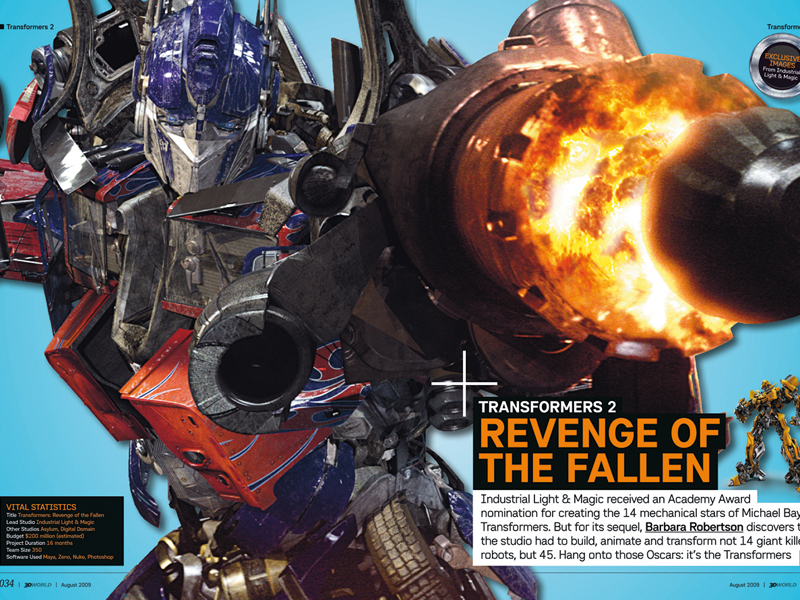The making of Transformers 2
How ILM and Digital Domain pushed CGI to the limits

Could Sam Witwicky (Shia LaBeouf) really go off to college and leave the very hot Mikaela Banes (Megan Fox) and Bumblebee, his giant robot friend and protector, behind? He really tries, despite Mikaela's obvious charms, and even though Bumblebee cries windshield-washer tears.
But director Michael Bay has something else in mind to distract Sam from his studies: robots. Scores of robots. Big, brutal transforming warriors and nasty, clever little helpers – and they're all out for Sam's blood. Yes, it's Transformers 2, otherwise known as Transformers: Revenge of the Fallen – and the effects are bigger and bolder than ever.
For 2007's Transformers, which raked in more than $700 million at the box office, lead VFX studio Industrial Light & Magic turned the cool little 1980s Hasbro toys into 14 bone-crushing giants that crashed through the streets of Los Angeles, smashing buildings and each other in over-the-top, rock-hard action sequences. But that was just a warm-up for Revenge of the Fallen.
The sequel blasts your eyes with thousands of hard metal parts, spinning and sliding gears, wheels, crankshafts, pistons and headlamps as nearly 60 jaw-dropping robots take their battle to seven states, three countries, and one alien planet. Add in another 40 CG vehicles, and the total count is more than 100 major 3D assets.
Massing the troops
As before, ILM took the lead in the effects work, creating both the lion's share of the robots – 45 in total – and the largest and most complex machines. The studio created all of the heroic Autobots, including their returning leader, Optimus Prime; and many of the evil Decepticons, including both Megatron – seemingly destroyed at the end of the first movie – and the megamonster Devastator, who is five times the size of Optimus Prime.
"The locations, the effects, the style are all huge," says ILM's Scott Farrar, who reprises his role of VFX supervisor from the original movie. Rendering shots for Transformers took between 16 and 20 terabytes of disk space in the studio's renderfarm. Transformers: Revenge of the Fallen took 140 terabytes. "The amount of render time is colossal," Farrar says. "The whole movie is that way."
Get daily insight, inspiration and deals in your inbox
Sign up for breaking news, reviews, opinion, top tech deals, and more.
Bay's own studio, Digital Domain, created 13 Decepticons, ranging in size from little ball-bearing 'microcons' that transform into a razor-bladed creature called Reedman to the enormous Soundwave, which links up to communications satellites. Digital Domain also created Wheelie, a rascally little bot transformed from a remote control vehicle, and Alice, the 'pretender' who transforms from a human seductress.
Human qualities
Such human qualities are one of the most significant ways in which the robots in Revenge of the Fallen differ from those of their predecessors. "People will be amazed at the interaction of the robots with the environment," Farrar says. "They kick up dirt. They interact with trees. And they sweat, spit, drip, and squirt fluids like blood." The fluids, which help give the robots a more organic feel, were added almost as an afterthought.
For a shot in which Starscream, one of the returning Decepticons, has to react to Sam, ILM was tasked with finding ways to make the interaction more dramatic. The solution was simple, but crucial: "We decided to have Starscream spit at Sam," says associate visual effects supervisor Jeff White. The effect worked so well that the animators began looking for more opportunities to have the robots dispense water, sparks, gas and smoke.
This more organic approach carried over into the design of the Transformers themselves. The robots' faces have been given significantly more human characteristics, enabling them to act, emote and talk. In total, 40 of the robots have at least one line of dialogue.
"In the last movie, a small number of robots had a couple of lines," says animation director Scott Benza. "This time, there is a lot more dialogue; and a lot more important dialogue to help carry the story." With little more than a year to complete the effects, ILM significantly increased the size of the animation team to cope with the increased scope of the project. "We had fewer than 20 animators on the first film," says Benza. "This time, we had over 50 because we had so many more robots, and three times the complexity of the work."
Matching jobs to skills
With animators often facing complicated 500-frame shots with three robots, Benza cast his staff according to their skill sets. "Some animators were interested in animating particular scenes, so I'd shift things around to give them a chance to do those shots," he says. "Specialists in animal behaviour would get the Ravage shots because he was a cat-based Decepticon. Others were specialists in dialogue and acting performances."
To create these performances, team members were aided by a rigging system developed by ILM for the previous movie, through which they could choose what parts of the model to connect. "An animator can animate any individual part or any groups of parts," Benza says. In addition, a new system provided the animators with a little procedural help on the more complex shots.
"The creature development team gave us the flexibility to put the robots into any pose and not have interpenetrations in adjoining areas," Benza says. "With so many moving parts, it's quite a task to make sure every individual part doesn't collide with its neighbours."
But even with the rigging system to call upon, the first pass at preventing penetrations was carried out by hand – and with Benza, normally in charge of procedural animation, busy in a supervisory role – there were no shortcuts for final-quality animation, either. For example, the Decepticon Scorponok, which was procedurally animated on the original movie, is now entirely keyframed.